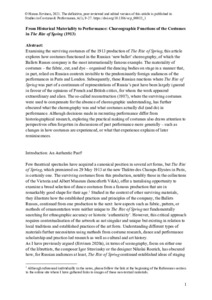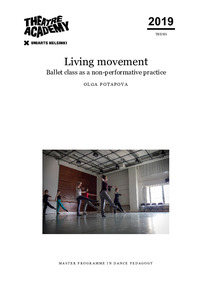Selaus asiasanan mukaan kokoelmassa "baletti (taiteet)"
Viitteet 1-7 / 7
-
Ballets Russes and Blackface
(Cambridge University Press; Dance Studies Association, 2020)
lehtiartikkeliPrompted by Achille Mbembe's reading of how racial assignation functions, this article examines the recurrences of two blackface ballet characters, the Golden Slave in Schéhérazade and the Blackamoor in Petrouchka, on ... -
Dance arts : historical perspectives and contemporary practices
Monni, Kirsi (toim.); Laakso, Riikka (toim.); Järvinen, Hanna (toim.)
Teatterikorkeakoulun julkaisusarja : 79 (Taideyliopiston Teatterikorkeakoulu, 2023)
verkkosivustoThis book is based on the 2022 textbook, Näkökulmia tanssitaiteen historiaan ja nykypäivään, the first comprehensive presentation in Finnish of the historical trajectories and features of Western dance as a performing art. ... -
From historical materiality to performance : Choreographic functions of the costumes in The Rite of Spring (1913)
(Intellect, 2021)
lehtiartikkeliExamining the surviving costumes of the 1913 production of The Rite of Spring, this article explores how costumes functioned in the Russian ‘new ballet’ choreography, of which the Ballets Russes Company is the most ... -
Historical materiality of performance : On the costumes of The Rite of Spring (1913)
(Intellect, 2020)
lehtiartikkeliBy focusing on surviving costumes of the 1913 production of The Rite of Spring, this article asks how a close examination of costumes and their role in historical performance practice can change our understanding of a ... -
Living movement : ballet class as a non-performative practice
(2019)
opinnäyte (maisteri)This thesis work is an attempt to investigate ballet class as a practice without a specific focus on the performative aspects. Taking the inspiration from the martial arts practices, this research touches the issues of ... -
Näkökulmia tanssitaiteen historiaan ja nykypäivään
Monni, Kirsi (toim.); Laakso, Riikka (toim.); Järvinen, Hanna (toim.)
Teatterikorkeakoulun julkaisusarja : 75 (Taideyliopiston Teatterikorkeakoulu, 2022)
verkkosivustoKirja on ensimmäinen suomenkielinen kokoava esitys länsimaisen esittävän taidetanssin historiallisista kehityslinjoista ja pääpiirteistä. Se on lähestyttävä yleisteos, joka kuvailee, esittää ja analysoi taidetanssia ... -
On “Contemporaneity” in Ballet and Contemporary Dance : Jeux in 1913 and 2016
(Oxford University Press, 2021)
kirjan osaDanced histories are not linear but circular, as dancing bodies return and reinterpret past dances. Theorizing the import of contemporaneity as an evaluative notion, this chapter examines a practice-based research ...




